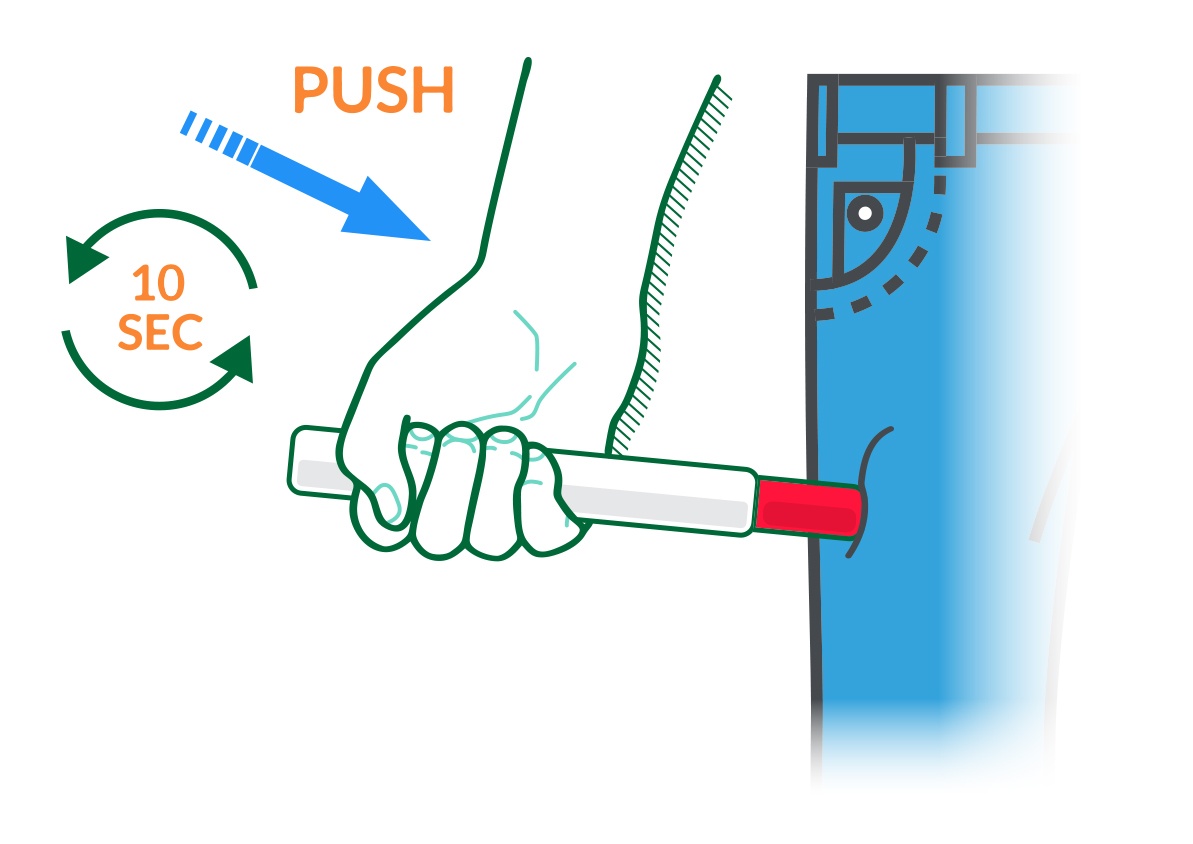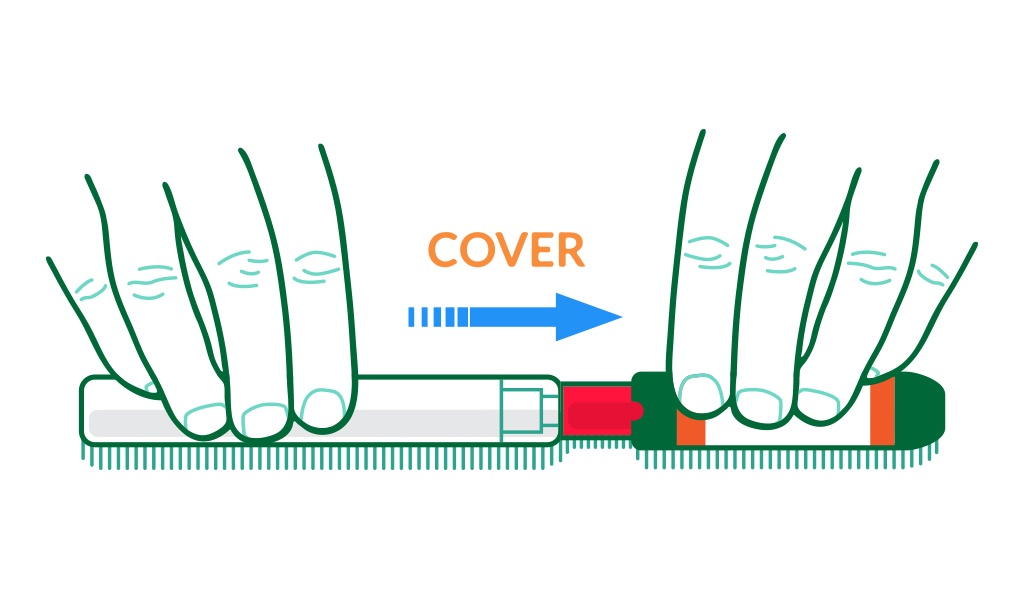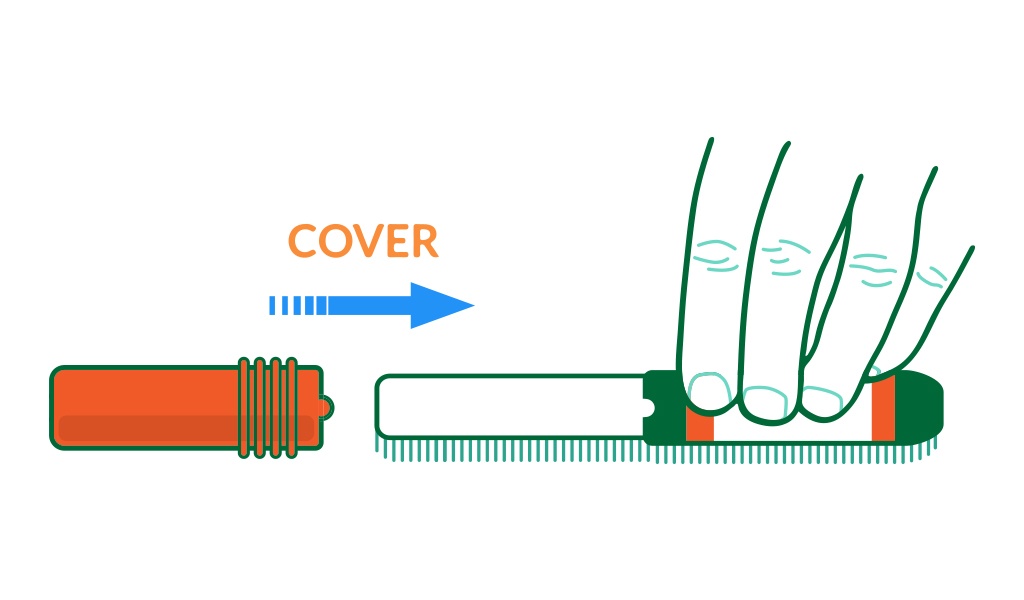

MENU
How to use the Epinephrine Injector?
To start, ask your healthcare provider to show you the proper way to use your epinephrine injection, USP auto-injector. Please read the Patient Information Leaflet carefully after filling and refilling your prescription. There may be new information in this leaflet that you or those who you trust to administer injections (parents, caregivers, school nurses) should know. Reading the leaflet ensures you know how to use the injector during a severe allergic reaction, and it contains details beyond those in the quick-reference instructions. In addition, our free Product Trainers let you practice using an injector properly without an injection occurring.
How to Use
To start, ask your healthcare provider to show you the proper way to use your epinephrine injection, USP auto-injector. Please read the Patient Information Leaflet carefully after filling and refilling your prescription. There may be new information in this leaflet that you or those who you trust to administer injections (parents, caregivers, school nurses) should know. Reading the leaflet ensures you know how to use the injector during a severe allergic reaction, and it contains details beyond those in the quick-reference instructions. In addition, our free Product Trainers let you practice using an injector properly without an injection occurring.
Please watch the instructional video
Take the time to view this now, so you’ll know exactly how to use your epinephrine auto-injector in an emergency. This information does not replace talking with your doctor about your medical condition or your treatment.
Instructions for Using the Epinephrine Injection, USP Auto-Injector for both the epinephrine auto-injector 0.15 mg and the epinephrine auto-injector 0.3mg.

Figure A
STEP 1. Prepare epinephrine injection, USP auto-injector for injection
Remove epinephrine injection, USP auto-injector from its protective carrying case. Pull off blue end caps; you will now see a red tip. Grasp the auto-injector in your fist with the red tip pointing downward. See Figure A.
Note
The needle comes out of the red tip. To avoid an accidental injection, never put your thumb, fingers, or hand over the red tip. If an accidental injection happens, get medical help right away.

Figure B
STEP 2. Administer epinephrine injection, USP auto-injector
If you are administering epinephrine injection, USP auto-injector to a young child, hold the leg firmly in place and limit movement prior to and while administering an injection. Put the red tip against the middle of the outer thigh (upper leg) at a 90° angle (perpendicular) to the thigh. Press down hard and hold firmly against the thigh for approximately 10 seconds to deliver the medicine. See Figure B. The auto-injector is designed to work through clothing.
Only inject into the middle of the outer thigh. Do not inject into any other part of the body. Remove epinephrine injection, USP auto-injector from the thigh. Massage the area for 10 seconds. Check the red tip. The injection is complete and you have received the correct dose of the medicine if you see the needle sticking out of the red tip. If you do not see the needle repeat Step 2.
STEP 3.
Get emergency medical help right away.
You may need further medical attention. You may need to use a second epinephrine injection, USP auto-injector if symptoms continue or recur. Only a healthcare provider should give additional doses of epinephrine if you need more than 2 injections for a single anaphylaxis episode.

Figure C
STEP 4. After use/disposal
Carefully cover the needle with the carrying case. Lay the labeled half of the carrying case cover down on a flat surface. Use one hand to carefully slide the end of the auto-injector, needle first, into the labeled carrying case cover. See Figure C.

Figure D
After the needle is inside the labeled cover, push the unlabeled half of the carrying case cover firmly over the non-needle end of the auto-injector. See Figure D. Take your used epinephrine injection, USP auto-injector with you when you go to see a healthcare provider. Tell the healthcare provider that you have received an injection of epinephrine. Show the healthcare provider where you received the injection. Give your used epinephrine injection, USP auto-injector to the healthcare provider for inspection and proper disposal.
Ask for a refill, if needed. Each single-dose epinephrine injection, USP auto-injector is designed to provide accurate delivery of a complete dose of epinephrine when it is needed most.
Since you cannot predict when a life-threatening allergic reaction (anaphylaxis) will occur, carry your epinephrine, USP auto-injector at all times.
Remember, after using the epinephrine, USP auto-injector, you must obtain emergency medical treatment right away.
Notes
-
-
-
-
Epinephrine injection, USP auto-injector is a single-use injectable device that delivers a fixed dose of epinephrine. The auto-injector cannot be reused. Do not attempt to reuse epinephrine injection, USP auto-injector after the device has been activated. It is normal for most of the medicine to remain in the auto-injector after the dose is injected. The correct dose has been administered if you see the needle sticking out of the red tip.
-
-
-
A separate epinephrine injection, USP auto-injector Trainer is available. The epinephrine injection, USP auto-injector Trainer has a beige color. The beige epinephrine injection, USP auto-injector Trainer contains no medicine and no needle. Practice with your epinephrine injection, USP auto-injector Trainer, but always carry your real epinephrine injection, USP auto-injector in case of an allergic emergency.
-
-
-
If you will be administering epinephrine injection, USP auto-injector to a young child, ask your healthcare provider to show you how to properly hold the leg in place while administering a dose.
-
-
-
Do not try to take the epinephrine injection, USP auto-injector apart.
-
-
-
Tips
-
-
- Do NOT remove the blue caps until you’re ready to use the epinephrine auto-injector.
-
- Keep your epinephrine injection, USP auto-injector at room temperature: 68°-77°F (20°-25°C). Avoid exposing to extreme heat or cold. For example, do not store in your vehicle’s glove box or in the refrigerator or freezer.
-
- Protect epinephrine injection, USP auto-injector from light.
-
- Check your epinephrine injection, USP auto-injector regularly. The solution should be clear. Replace it if it has expired, or if the medicine is cloudy, discolored (pinkish or brown), or has particles in it.
-
- The epinephrine injection, USP auto-injector is not waterproof, so if it is ever submerged in water or any other liquid, it cannot be used. If this occurs, obtain a replacement.
-
- In the case of accidental injection, go immediately to the nearest emergency room.
-
- Be sure to read the Patient Information Leaflet carefully.
-
Notes
-
-
-
-
Epinephrine injection, USP auto-injector is a single-use injectable device that delivers a fixed dose of epinephrine. The auto-injector cannot be reused. Do not attempt to reuse epinephrine injection, USP auto-injector after the device has been activated. It is normal for most of the medicine to remain in the auto-injector after the dose is injected. The correct dose has been administered if you see the needle sticking out of the red tip.
-
-
-
A separate epinephrine injection, USP auto-injector Trainer is available. The epinephrine injection, USP auto-injector Trainer has a beige color. The beige epinephrine injection, USP auto-injector Trainer contains no medicine and no needle. Practice with your epinephrine injection, USP auto-injector Trainer, but always carry your real epinephrine injection, USP auto-injector in case of an allergic emergency.
-
-
-
If you will be administering epinephrine injection, USP auto-injector to a young child, ask your healthcare provider to show you how to properly hold the leg in place while administering a dose.
-
-
-
Do not try to take the epinephrine injection, USP auto-injector apart.
-
-
-
Tips
-
-
- Do NOT remove the blue caps until you’re ready to use the epinephrine auto-injector.
-
- Keep your epinephrine injection, USP auto-injector at room temperature: 68°-77°F (20°-25°C). Avoid exposing to extreme heat or cold. For example, do not store in your vehicle’s glove box or in the refrigerator or freezer.
-
- Protect epinephrine injection, USP auto-injector from light.
-
- Check your epinephrine injection, USP auto-injector regularly. The solution should be clear. Replace it if it has expired, or if the medicine is cloudy, discolored (pinkish or brown), or has particles in it.
-
- The epinephrine injection, USP auto-injector is not waterproof, so if it is ever submerged in water or any other liquid, it cannot be used. If this occurs, obtain a replacement.
-
- In the case of accidental injection, go immediately to the nearest emergency room.
-
- Be sure to read the Patient Information Leaflet carefully.
-
IMPORTANT SAFETY INFORMATION
Epinephrine injection, USP auto-injector is intended for immediate administration as emergency supportive
therapy and is not intended as a substitute for immediate medical care. In conjunction with the administration of
epinephrine, the patient should seek immediate medical or hospital care. More than two sequential doses of
epinephrine should only be administered under direct medical supervision.
Epinephrine injection, USP auto-injector should ONLY be injected into the anterolateral aspect of the thigh. Do not
inject intravenously. Do not inject into buttock. Do not inject into fingers, hands or feet. Instruct caregivers to
hold the child’s leg firmly in place and limit movement prior to and during injection to minimize the risk of injection
related injury.
Epinephrine should be administered with caution to patients who have heart disease, including patients with
cardiac arrhythmias, coronary artery or organic heart disease, or hypertension. In such patients, or in patients who
are on drugs that may sensitize the heart to arrhythmias, epinephrine may precipitate or aggravate angina pectoris
as well as produce ventricular arrhythmias. Arrhythmias, including fatal ventricular fibrillation, have been reported
in patients with underlying cardiac disease or those receiving certain drugs. Patients who receive epinephrine
while concomitantly taking cardiac glycosides, diuretics or anti-arrhythmics should be observed carefully for the
development of cardiac arrhythmias. Epinephrine should be administered with caution to patients with
hyperthyroidism, diabetes, elderly individuals, and pregnant women. Patients with Parkinson’s disease may notice
a temporary worsening of symptoms.
Rare cases of serious skin and soft tissue infections, including necrotizing fasciitis and myonecrosis caused by
Clostridia, have been reported at the injection site following epinephrine injection for anaphylaxis. Advise patients
to seek medical care if they develop signs or symptoms of infection.
IMPORTANT SAFETY INFORMATION
What is the most important information I should know about epinephrine injection, USP auto-injector?
- Epinephrine injection, USP auto-injector contains epinephrine, a medicine used to treat allergic emergencies (anaphylaxis). Anaphylaxis can be life-threatening, can happen within minutes, and can be caused by stinging and biting insects, allergy injections, foods, medicines, exercise or other unknown causes. Symptoms of anaphylaxis may include:
- trouble breathing
- wheezing
- hoarseness (changes in the way your voice sounds)
- hives (raised reddened rash that may itch)
- severe itching
- swelling of your face, lips, mouth, or tongue
- skin rash, redness, or swelling
- fast heartbeat
- weak pulse
- feeling very anxious
- confusion
- stomach pain
- losing control of urine or bowel movements (incontinence)
- diarrhea or stomach cramps
- dizziness, fainting, or “passing out” (unconsciousness).
